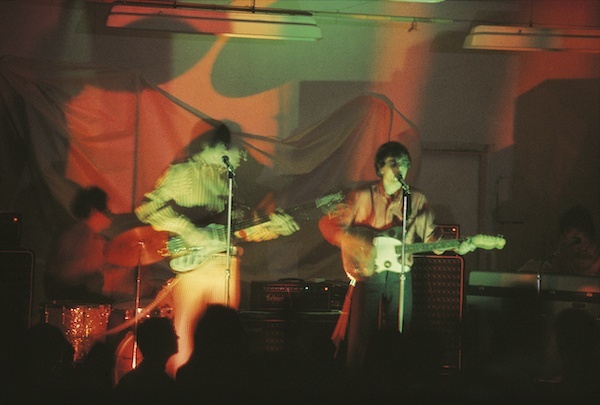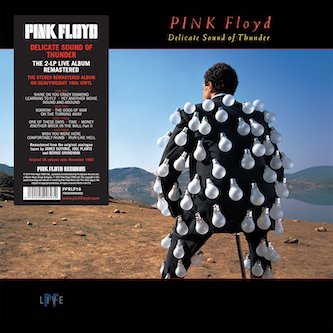Book/Music Review: “Barrett: The Definitive Visual Companion” and Pink Floyd’s “Delicate Sound of Thunder”
By Adam Ellsworth
For fans of Pink Floyd, the book’s first half, with its treasure trove of early Floyd photos, is the main draw.
Barrett: The Definitive Visual Companion by Russell Beecher and William Shutes. 272 pages, $50 (paperback).

Once upon a time, Syd Barrett sat at the center of Pink Floyd. Syd was the focal point. He was the singer, the songwriter, and the creative force. And then…he wasn’t.
Syd had become unreliable. At a gig a few days before Christmas 1967, he had to be ushered onto the stage, where he proceeded to stand stock-still, his guitar hanging from his shoulders, while his three bandmates carried on without him. Weeks earlier, he had wandered off for a walk prior to a show, didn’t make it back in time for the set, and needed to be replaced by a stand-in.
Beyond his onstage troubles, the hits were drying up as well. The genius who had only months earlier produced the pop perfection of “Arnold Layne” and “See Emily Play,” was now penning “Vegetable Man,” “Scream Thy Last Scream,” and “Jugband Blues.” More than half a century later, these latter songs are correctly heralded as classics in their own right, but they were never going to set the pop charts on fire.
Clearly something had to be done. The initial something was to transform the Floyd into a quintet, with David Gilmour brought in as a second guitarist. With Gilmour in the group, it didn’t really matter if Syd wandered off, or stood motionless onstage. The show could go on regardless and if Syd decided to participate, all the better. Ultimately, this incarnation of Pink Floyd lasted one photoshoot and four gigs.
It was during the drive to the fifth gig that the fateful decision was made. All members of the band were riding together, save for their original creative force. Someone asked, “Shall we collect Syd?” The answer came back negative, and that was that.
Not to spoil anything for anybody, but Pink Floyd did okay without him. That’s no criticism of Syd, it’s just stating the obvious fact that Pink Floyd 2.0 was one of the most successful rock bands of all time. And yet Syd remains beloved by many. He has never been forgotten or lost to history.
Since his death from pancreatic cancer in 2006, interest in his life and work has only grown. Books and articles about Syd were of course produced while he was still alive, but it was the arrival of Rob Chapman’s superb Syd Barrett: A Very Irregular Head in 2010 that finally separated the facts of Syd’s life from the fantasies and legends. A year later, Russell Beecher and Will Shutes published the beautiful Barrett: The Definitive Visual Companion, which this month has been released for the first time in paperback. As the subtitle would imply, the book is not a biography of Syd, but a visual overview of his life and career. It includes photographs taken during his time in Pink Floyd as well as his solo career, correspondence with childhood sweethearts, and 100 pages dedicated to every known piece of visual art Syd created in his life.

Syd Barrett onstage at UFO in London, c. 1966/1967. Photo: Anthony Stern.
For fans of Pink Floyd, the book’s first half, with its treasure trove of early Floyd photos, is the main draw. The number of “posed” band shots included in the volume are of only minimal interest (though they do offer an amusing look at some of the band’s more outlandish sartorial choices), but the photos of the group onstage, “lost in the light show,” wonderfully capture the band as kings of Swinging London. In many of the photos, the band members are completely out of focus, in some cases doubled or tripled. It’s hard to say if the photographers “meant” to present the Floyd in this way, and yet it seems totally appropriate. It is no doubt an accurate depiction of what it was like to be in the audience, watching the out-of-focus figures onstage blend into the backdrop while psychedelic sounds swirled around the room.
Images from most of the Floyd’s major “event” performances are included in the book: the launch of International Times at the Roundhouse, the London Free School Benefit, and the 14 Hour Technicolor Dream at Alexandra Palace. Interestingly, there are no photos from the band’s Games for May performance at Queen Elizabeth Hall, though there are a number of candid shots of the group rehearsing for the show, including one of Syd holding what appears to be a toy duck up to his microphone, presumably to amplify some whimsical sound that only he would think to incorporate into a rock song.
Unsurprisingly, the band’s live home base UFO is well represented in the photographs. Located on Tottenham Court Road in London, UFO was really only UFO on Friday nights. The location was otherwise the Blarney Club, a not very hip Irish dance hall. For that one night a week though, 31 Tottenham Court Road was the swingingest spot in Swinging London. Of all the UFO shots included in the collection, the best photo (which is maybe the best image in the entire book) was by photographer Adam Ritchie. Spread across two pages of Barrett, the shot, taken from the side of the stage directly behind keyboard player Richard Wright, captures the audience, Pink Floyd, and a tiny backstage area all in one frame. The audience is mostly sitting on the floor, the band are concentrating on their instruments. If this was the scene in its entirety, it would be unremarkable. But on the far right of the photo, we are shown behind the basic white sheet that acted as the backdrop to the stage. What do we see? Cheap, maybe even homemade, Christmas decorations affixed to the wall, no doubt put there by the owners of the Blarney Club to spread some holiday cheer to the proudly not turned on folks who filed into the club the other six nights of the week. In one photograph, we have a reminder that you really can start a scene anywhere. Of course, just because you do, it doesn’t mean you’ve taken over the world.
The next to last photo included in the Pink Floyd section of Barrett is one of the very few shots to show the group as a quintet, with both Syd and David Gilmour as members. Bassist Roger Waters, keyboardist Richard Wright, and drummer Nick Mason are all clearly aware they are taking part in a photo shoot, and are happy to “pose” for the camera. Gilmour, in the back, seems uncomfortable with the situation, but he’s at least willing to look into the lens. As for Syd, no one in the history of rock and roll has ever given less fucks about a promotional duty. His arms are crossed, his hair — which at its most glorious was Syd’s best feature — looks like it hasn’t been washed in a month, and his sunken eyes are staring (glaring?) a hundred yards off to his left. Perhaps he’s reading some far off writing on the wall? Perhaps he’s just waiting to be put out of his misery.
There is a small section of the book dedicated to photos taken during Syd’s brief post-Floyd solo career. These are mostly depressing to look at, though that says more about the subject and his mental state than the talents of the photographers (Storm Thorgerson and Mick Rock among them). Far happier is the chapter that reproduces letters — complete with doodles, poems, and all around playfulness — Syd wrote to girlfriends during the mid-’60s. There’s a particularly amusing letter Syd wrote to his on-again-off-again girlfriend Libby Gausden as if he were a 5-year-old. “Once there was a girl named Elisabeth who lived in a house,” Syd writes in grade school cursive, “and had two sisters. A budgey and a cat. She had a mumy [sic] and a daddie [sic] and a grandfather and a boyfriend.” “And a boyfriend” is then repeated in smaller and smaller writing until it disappears. It’s not much of a leap from the teenager who wrote this letter to the young man who would write the childlike songs on Pink Floyd’s The Piper at the Gates of Dawn.

Pink Floyd performing on October 21, 1966, at the London Free School Benefit Concert, Notting Hill, London. Photo: Graham Keen.
Once Barrett reaches its second half, the book stops being about “Syd” and starts being about “Roger.” “Syd” was a musician. “Roger,” his birth name, was an artist. If Syd never existed, would Roger have risen to the same level of fame? Would we even care about his visual art? The smart money says “No” to both of these questions, but that is not to suggest that Roger was without genuine talent. Who knows how his career would have unfurled had he never formed Pink Floyd. If, instead, he has stayed enrolled all three years at Camberwell School of Arts and Crafts.
For those qualified to judge Roger’s artistic talents, Barrett offers a lifetime of evidence to aid in reaching a verdict one way or the other. It’s all here. Every known painting, drawing, and sculpture. It’s a relief that we have the photographs of the work we have; even in his art school days Roger would often destroy his work as soon as it was completed. As Barrett explains, this wasn’t a sign that Roger was a tortured artist, it was simply an acknowledgment that the work was finished. Once finished, why keep it hanging around? On to the next thing. Keep moving forward. Pink what?
The remastered release of Delicate Sound of Thunder is welcome, in the sense that this version offers a more accurate representation of what Pink Floyd actually performed during the tour.
 If Pink Floyd 2.0 had a leader, it was Roger Waters. The bassist didn’t write all the music, or sing all the songs, but he wrote the lyrics and provided the Big Ideas that drove the band. Among the results of this approach were Dark Side of the Moon, Wish You Were Here, and The Wall. Not a bad track record, though as the ’70s wore on, life in the band was becoming unbearable for everyone not named “Roger Waters.” Things got really ugly when Richard Wright was fired during the 1979 recording sessions for The Wall. Pink Floyd entered the ’80s as a trio and produced 1983’s The Final Cut, but the album was a Waters solo record in all but name.
If Pink Floyd 2.0 had a leader, it was Roger Waters. The bassist didn’t write all the music, or sing all the songs, but he wrote the lyrics and provided the Big Ideas that drove the band. Among the results of this approach were Dark Side of the Moon, Wish You Were Here, and The Wall. Not a bad track record, though as the ’70s wore on, life in the band was becoming unbearable for everyone not named “Roger Waters.” Things got really ugly when Richard Wright was fired during the 1979 recording sessions for The Wall. Pink Floyd entered the ’80s as a trio and produced 1983’s The Final Cut, but the album was a Waters solo record in all but name.
As far as Waters was concerned, The Final Cut was the end of the band. Why continue? He was going to go solo, and, after all, by this point, he was the driving force in Pink Floyd, so therefore Pink Floyd was finished.
David Gilmour and Nick Mason didn’t see it that way. If Waters wanted to leave, that was on him. They (with Wright kind of sort of back in the fold) weren’t done yet. After all, it wasn’t as if Pink Floyd had never shed its main creative force before.
And with that, Pink Floyd 3.0 was born. It took some major legal wrangling, but in the end, Waters was out, and the rest carried on.
The Waters-less Floyd released A Momentary Lapse of Reason in 1987. Producer Bob Ezrin played bass, session musicians augmented Mason on the drums, and the lyrics were written by non-Floydians. Asked by journalist David Fricke what he thought of the record, Waters responded, “I think it’s very facile, but a quite clever forgery.” Perhaps harsher than how Gilmour, Mason, and Wright would have described it but, in a way, wasn’t that the point? The remaining band members didn’t do it all by themselves (there was a lot of help) but they managed to produce something that — to the record-buying public anyway — sounded like Pink Floyd.
With the album out, the three remaining members of the Floyd hit the road. They were supported by a number of backing musicians, but again, it sounded like Pink Floyd, and the tour produced the 1988 live album Delicate Sound of Thunder. The double album received a remaster in 2019 and along with additional songs was included on the group’s box set The Later Years. Earlier this month, the remastered version was released on its own, in CD as well as DVD/Blu-ray formats.
The remastered release of Delicate Sound of Thunder is welcome, in the sense that this version offers a more accurate representation of what the band actually performed during the tour. It contains eight songs left off the original release (including “The Great Gig in the Sky” and “Welcome to the Machine”) and also restores previously shortened versions of some songs to their full length. As a historical document, then, this 2019 remaster should be considered the definitive version of the album.
Unfortunately, regardless of the version, Delicate Sound of Thunder can be a slog to listen to. The album starts well, with a faithful rendition of the iconic 1975 track “Shine on You Crazy Diamond (Parts 1-5)” (Syd being the “crazy diamond” the band was paying tribute to), and then it settles into A Momentary Lapse of Reason in its near entirety. On the one hand, it is very on-brand for Pink Floyd to play a new album pretty much front to back in concert. On the other hand, A Momentary Lapse of Reason is not exactly The Wall. The album did produce two songs — ”Learning to Fly” and “On the Turning Away” — that remain classic rock staples, and the nine-plus minute version of “On the Turning Away” on Delicate Sound of Thunder is a highlight.
The lesser known Momentary Lapse song “Sorrow” also rises to the occasion, bolstered by “Young Lust” guitars and Gilmour’s ripper of a solo. As for the rest of the post-Waters material, it’s Floyd-by-numbers. Fine in small doses, but a lot to sit through when you really just want to hear something from the good old days.
In the second half, Delicate Sound of Thunder does deliver the hits, starting with a killer run-through of “One of These Days,” but so many of the performances here seem to rush. Perhaps someone with a metronome and too much free time can disprove this, but “Time,” “Wish You Were Here,” “Welcome to the Machine,” and “Run Like Hell” all feel a hair too fast. This isn’t so much of a problem on the final track, as “Run Like Hell” is a true rocker and a revved-up live version is to be expected, but those other tracks require just the right amount of lull. Too slow, and it’s boring, but too fast and the spell is broken. The versions here have no magic.
If there’s one classic that comes through on Delicate Sound of Thunder, it’s “Comfortably Numb.” Next to the incomparable studio version from The Wall, this rendition is of course not worthy, but it’s also just different enough to be interesting. On the original, Waters sang the verses while Gilmour handled the choruses. With that no longer an option, the verses here are performed as an ensemble with the voices of Wright and touring bassist Guy Pratt dominating. There’s something metallic about the vocals, as if they’re coming through some kind of processor, that gives the song just the right modern (for 1988 anyway) twist. Before the track strays too far off the beaten path though, Gilmour enters with the familiar, spine-tingling refrain:
There is no pain you are receding
A distant ship smoke on the horizon
You are only coming through in waves
Your lips move but I can’t hear what you’re saying
Only Roger Waters could have written those words, but only David Gilmour could have sung them. And whenever he sings them, regardless of who is or isn’t playing behind him, it really does sound like Pink Floyd.
Adam Ellsworth is a writer, journalist, and amateur professional rock and roll historian. His writing on rock music has appeared on the websites YNE Magazine, KevChino.com, Online Music Reviews, and Metronome Review. His non-rock writing has appeared in the Worcester Telegram and Gazette, on Wakefield Patch, and elsewhere. Adam has an MS in journalism from Boston University and a BA in literature from American University. He grew up in Western Massachusetts, and currently lives with his wife in a suburb of Boston. You can follow Adam on Twitter @adamlz24.
Tagged: Barrett: The Definitive Visual Companion, Delicate Sound of Thunder, Pink Floyd, Roger Waters
